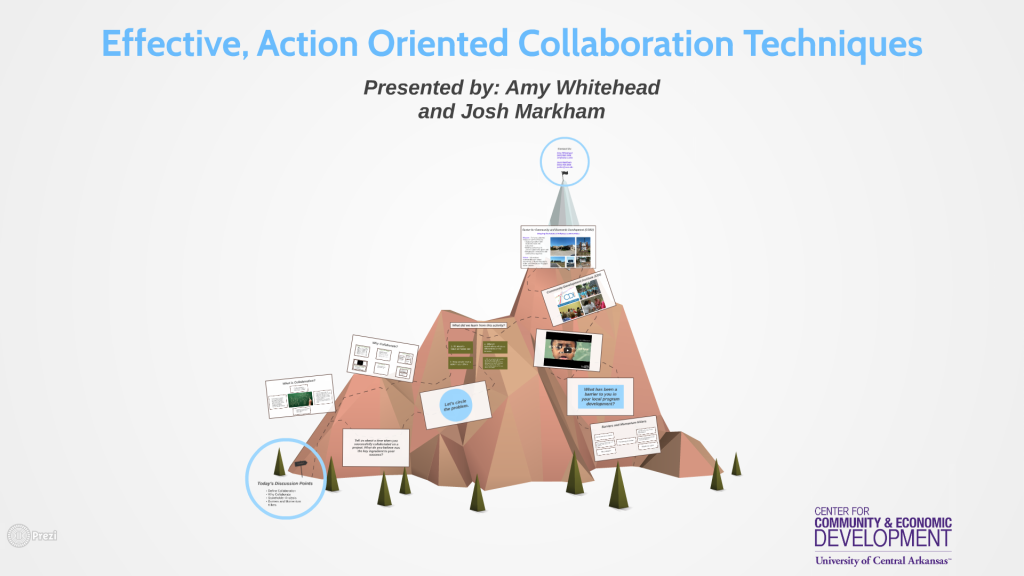To set up this particular blog post we can’t help but start off with a little song – so please feel free to listen as you scan over this post:
As a sponsor of Destination Downtown 2015, CCED Director Amy Whitehead and Project Coordinator Shelby Fiegel divided and conquered this year’s conference, which was hosted by Main Street Arkansas at the CALS Ron Robinson Theater in Little Rock.
Destination Downtown is a regional conference sponsored by Main Street Arkansas, and co-sponsored by Mississippi Main Street Association and Louisiana Main Street, attracting more than 200 professionals in preservation-based commercial district revitalization, including new and experienced downtown and neighborhood Main Street directors, board members, architects, planners, economic development professionals, public officials, volunteers and consultants. Attendees hailed from communities of all sizes, from small rural towns to urban neighborhoods in large cities.
Sessions included topics such as “Diversify Your Revenue Sources!,” “Implementing the Four Point Refresh: Stronger Strategies, Stronger Outcomes,” “Blogging on Main Street & Attracting Travel Bloggers,” “PopUp in the Rock: Connecting Underutilized Space and Creating Sense of Place,” “Crowdfunding for Public Spaces & Community Places: Community & Innovation Come Together for the Greater Good” and many other diverse subjects. Our team thoroughly enjoyed all the sessions we attended and learned about a multitude of new ideas, resources, skills, trends, and tricks of the tourism trade.
To keep this post short and concise, we want to share the best “snippets” of information we heard while attending the conference. They are as follows:
- We need a combination of public and private partnerships to rebuild our downtowns: place + space.
- To travel is to learn – go explore different places and learn from their successes and mishaps.
- Successful cities of today think smaller, but in a big way.
- The economic development environment has changed between the 20th century and 21st century. Ask yourself: are you keeping up, have you changed with it?
- “The best way to predict the future is to create it yourself.” – Abe Lincoln.
- “Distinct qualities and uniqueness are the only competitive advantage communities have.” – Ed McMahon.
- Successful cities are distinctive cities.
- “The future belongs to mixed-use development.” – Ed McMahon.
- The PLACE is becoming more important that the product.
- Sameness is a minus in the world we live in, it is not a plus. Be different.
- Community image is critical to economic vitality and quality of life.
- What are we building today that will be worth preserving in the future? Think deeply about this question.
- In your downtown, if you a parking problem that means you are successful.
- Communities that set no standards compete to the bottom.
- People who live downtown spend 40-60% of their disposable income downtown.
- Every $1 spent on downtown investments creates a $27 return.
- Keys to responsible tourism.
- Pop ups – re-imagining downtowns in the some of the most creative ways. Learn more here.
- Public Places, Community Spaces is a crowdgranting program. Absorb this idea, people! Seriously. Learn more at the Michigan Economic Development Corporation and Patronicity.
- “As the world becomes more technological, place becomes even more important.” – Warwick Sabin.
- Problem in the south: we lose our most talented people because they don’t have access to what they need to be successful – we need to provide that access.
We had a wonderful time learning, absorbing, and networking at Destination Downtown 2015! We look forward to Destination Downtown 2016 hosted by Louisiana Main Street in Ruston, Louisiana (especially since we received some peach flavored chap-stick to put us in a Ruston mood). But until next year – that’s all folks!







